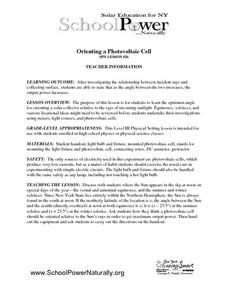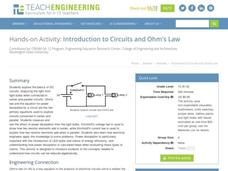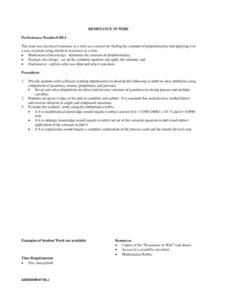Curated OER
Safety
Middle schoolers investigate the concept of voltage and electricity. They differentiate between an insulator and a conductor in the context of using electrical safety with the help of a doll house. Then students pretend the doll lives in...
Curated OER
Electromagnitism Applications
Students experiment on magnets and electricity. In this physics lesson, students determine what factors affect the strength of a magnetic field. They design an experiment to determine how electromagnetic field strength varies with distance.
Curated OER
Construction of an Ammeter and a Voltmeter from a Galvanometer
Students explore series and parallel circuits. In this physics lesson, students construct a simple circuit and measure its maximum current. They construct their own voltmeter and ammeter that operates at a specified range.
Curated OER
INTERNATIONAL FORUM ON IRAN'S NUCLEAR PROGRAM
Students research Iran and their position on nuclear power.
Curated OER
Circuits and Conductors
Students explore electricity by completing Internet activities. In this physical science lesson, students identify an electric circuit and describe the characteristics of conductors, giving examples as well. Students collaborate in...
Curated OER
TECH:Wind Power
Students generate electricity using a wind generator. They convert the created electricity into different forms of energy. It is written as a module. Students explain the impacts on society and the environment that the current energy and...
Curated OER
Capturing Renewable Energy
Learners watch a video segment on the engineering design process, then design a storage system for renewable energy. Students brainstorm and research ways in which renewable energies such as solar and wind power can be stored.
Curated OER
Capturing Renewable Energy
Young scholars watch a video segment on the engineering design process, then design a storage system for renewable energy. Students brainstorm and research ways in which renewable energies such as solar and wind power can be stored.
Curated OER
Capturing Renewable Energy
Students watch a video segment on the engineering design process, then design a storage system for renewable energy. Students brainstorm and research ways in which renewable energies such as solar and wind power can be stored.
Curated OER
Electrical Energy
Young scholars compare and contrast a cell and a battery. In this physical science lesson, students explain how they create energy. They conduct an experiment to apply what they have learned in this lesson.
California Academy of Science
Optimal and Sustainable: Renewable Energy Revamp
More than 100 cities around the world have shifted from fossil fuels to renewable energy sources. Scholars investigate a city wanting to make this switch, but needs help determining how to make the shift. Groups consider all options,...
Curated OER
Ohm's Law
If your future physicists know how to construct simple circuits, include resistors, and use a multi-meter to measure voltage, then you might employ this lesson on Ohm's law. Each lab group investigates the relationships among voltage,...
Curated OER
Orienting a Photovoltaic Cell
Students explore the optimum angle for orienting a solar collector relative to the rays of incoming sunlight. They review equinoxes, solstices, and various locational ideas before students investigate using meters, light sources, and...
Curated OER
Solar Kit Lesson #13 Solarize a Toy
Students work in teams they select a low-power toy, game, or electrical deive to "solarize," or convert to solar power. They determine the operating voltage of their chosen device and design a solar array to provide this level of...
Curated OER
Middle School Home Energy Audit
Seventh graders research the origins of local electrical power and compare costs and methods of generation with other areas of the country or world.
Teach Engineering
Introduction to Circuits and Ohm's Law
Take a very basic understanding of circuits and develop a strong understanding of the parts and function of a circuit. This activity is developed to be an independent exploration of circuits from the basics to series and parallel models....
Energy for Keeps
Going for a Spin: Making a Model Steam Turbine
Discover the effectiveness of wind, water, and steam as energy sources. The hands-on activity has young scientists create a turbine from common materials. After constructing the turbines, they use wind, water, and steam to turn them and...
Curated OER
Magneto-hydrodynamic Drives
Students examine how electric and magnetic fields can be used to force water out of a chamber to move a vehicle forward.
Curated OER
Renewable Energy in Connecticut - Softening Our Footprint through Sustainable Energy Use
High schoolers explore energy conservation. In this environmental lesson plan, students will look at data showing the amounts of energy used, our carbon footprint, and will research a power source. This unit allows for a deeper...
Curated OER
Resistance in a Wire
Students find the constant of proportionality and apply it to a situation. They use the electrical resistance in a wire as a context for finding the constant of proportionality. In addition, they write an explanation and justification of...
Curated OER
Parts of a Solar Panel-Part I
Students examine electrical contacts, solar cells, and rechargeable batteries and compare and contrast the characteristics of a solar cell to a rechargeable battery in a hands-on activity. Students complete a worksheet as they...
Curated OER
Artificial Heart Technology
Students discover the basics of the human heart and how it functions. They examine the whole circulatory system and how an electric heart would work inside the human body. They can choose to perform their own surgery by following...
Curated OER
A Case of Innovation
Students use strategies to comprehend technical writing. They write reports with great detail, supporting material, and clear vocabulary. They incorporate source materials into their speaking and writing and use voice, tone, and style.
Curated OER
Circuit Lab
Students explore the properties of electricity. This lab shows students the need for a circuit in order to have a flow of electricity. It demonstrates Ohm's law, which relates voltage, current, and resistance.























